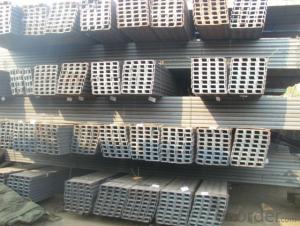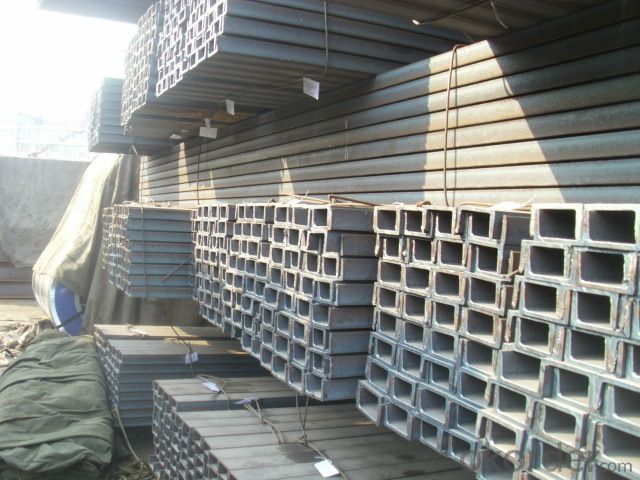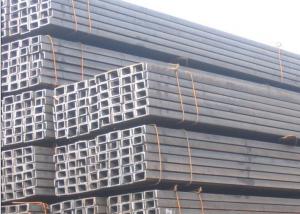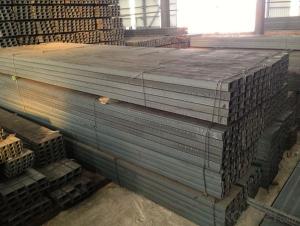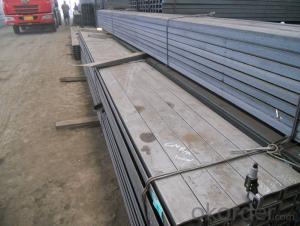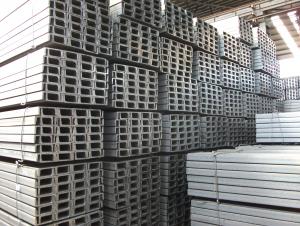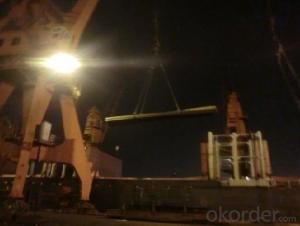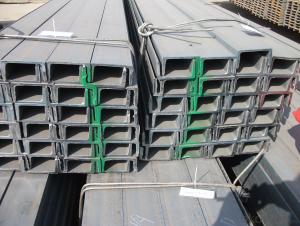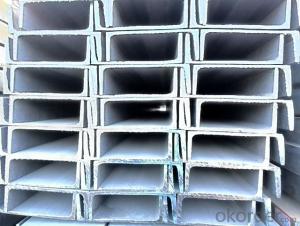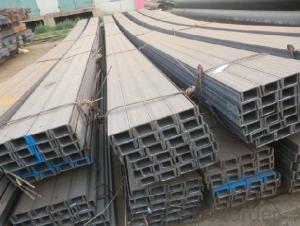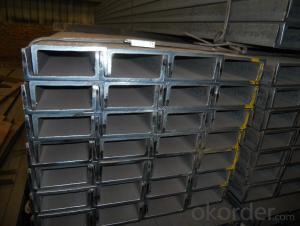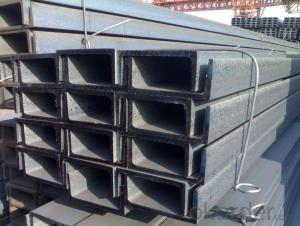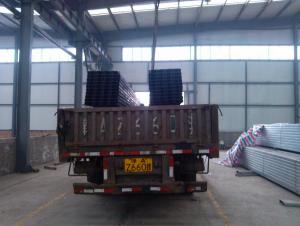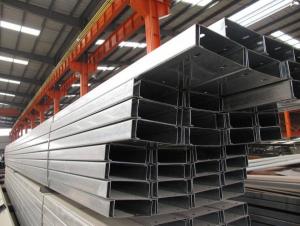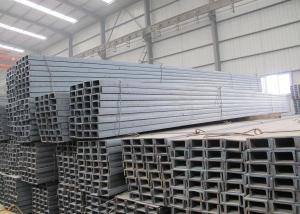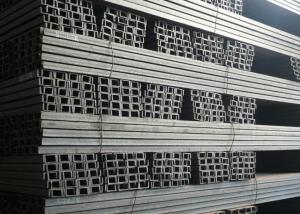Hot Rolled U-channel Steel Many Standards High Quality
- Loading Port:
- China Main Port
- Payment Terms:
- TT or LC
- Min Order Qty:
- -
- Supply Capability:
- -
OKorder Service Pledge
OKorder Financial Service
You Might Also Like
Product Description:
OKorder is offering STEEL CHANNEL at great prices with worldwide shipping. Our supplier is a world-class manufacturer of steel, with our products utilized the world over. OKorder annually supplies products to European, North American and Asian markets. We provide quotations within 24 hours of receiving an inquiry and guarantee competitive prices.
Product Applications:
The steel u channel can be applied to construction of warehouses, workshops, sport stadiums and car parks etc. In details, the steel u channel belongs to carbon structural steel which is applied to in the field of construction and machinery. The steel u channel is usually used for arch-itechtural structure, and they could be welded in order to support or hang a vari-ety of facilities. They are also usually used in combination with I beam. Generally,the steel u channel must possess perfect welding property, riveting property and mechanical property and so on.
Product Advantages:
OKorder's STEEL CHANNELare durable, strong, and resist corrosion.
Main Product Features:
· Premium quality
· Prompt delivery & seaworthy packing (30 days after receiving deposit)
· Corrosion resistance
· Can be recycled and reused
· Mill test certification
· Professional Service
· Competitive pricing
Product Specifications:
Standard | GB/JIS |
Material Grade | Q235,SS400 |
Technique: | Hot Rolled |
Sizes as per chinese standard: | 50*37*4.5mm - 300*89*11.5mm
|
Sizes as per japanese standard: | 50*25*3mm – 200*80*7.5mm |
Length: | 6meter, 9meter, 12meter |
Production Flow of JIS Channel:
1.The steel billet shall be heated in the high temperature furnace.
2. The heated steel billet shall be rolled five to nine times with the aim of shaping the general figure of steel u channel.
3. The rolled steel channel should be put onto the cooling bed to make the temperature low.
4. The JIS Channel should be straighted on the straightener.
5. The straighted steel u channel will be cut into meters by saw, as per customer's requirements.
6. At the last part of production, the channel steel must be tested in order to confirm that the finished products are completely free from crack, pore, slag, scab or fold on the surface.
| JIS U CHANNEL | Standard h | Sectional b | Dimension s | t | Mass: Kg/m |
| (mm) | (mm) | (mm) | (mm) | ||
| 50x25 | 50 | 25 | 3.0 | 6.00 | 2.37 |
| 75X40 | 75 | 40 | 3.8 | 7.00 | 5.30 |
| 75X40 | 75 | 40 | 4.0 | 7.00 | 5.60 |
| 75X40 | 75 | 40 | 4.5 | 7.00 | 5.85 |
| 75X40 | 75 | 40 | 5.0 | 7.00 | 6.92 |
| 100X50 | 100 | 50 | 3.8 | 6.00 | 7.30 |
| 100X50 | 100 | 50 | 4.2 | 6.00 | 8.03 |
| 100X50 | 100 | 50 | 4.5 | 7.50 | 8.97 |
| 100X50 | 100 | 50 | 5.0 | 7.50 | 9.36 |
| 125X65 | 125 | 65 | 5.2 | 6.80 | 11.66 |
| 125X65 | 125 | 65 | 5.3 | 6.80 | 12.17 |
| 125X65 | 125 | 65 | 5.5 | 8.00 | 12.91 |
| 125X65 | 125 | 65 | 6.0 | 8.00 | 13.40 |
| 150x75 | 150 | 75 | 5.5 | 7.30 | 14.66 |
| 150x75 | 150 | 75 | 5.7 | 10.00 | 16.71 |
| 150x75 | 150 | 75 | 6.0 | 10.00 | 17.90 |
| 150x75 | 150 | 75 | 6.5 | 10.00 | 18.60 |
FAQ:
Q1: Why buy Materials & Equipment from OKorder.com?
A1: All products offered byOKorder.com are carefully selected from China's most reliable manufacturing enterprises. Through its ISO certifications, OKorder.com adheres to the highest standards and a commitment to supply chain safety and customer satisfaction.
Q2: How do we guarantee the quality of our products?
A2: We have established an advanced quality management system which conducts strict quality tests at every step, from raw materials to the final product. At the same time, we provide extensive follow-up service assurances as required.
Q3: How soon can we receive the product after purchase?
A3: Within three days of placing an order, we will begin production. The specific shipping date is dependent upon international and government factors, but is typically 7 to 10 workdays.
Images:
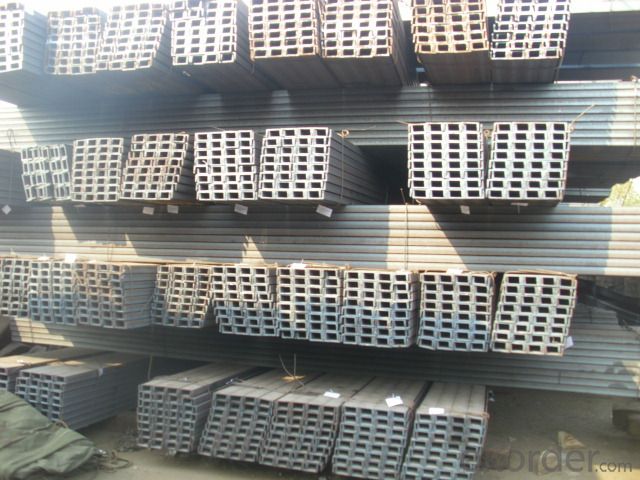
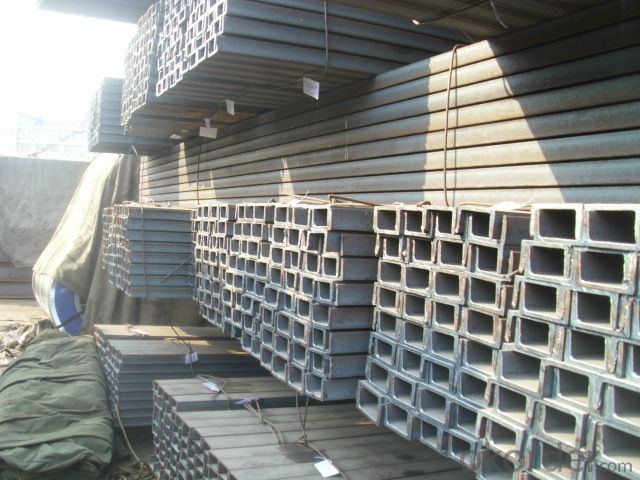
- Q: What are the different types of supports used for steel channels?
- There are several different types of supports that can be used for steel channels, depending on the specific application and load requirements. Some of the common types of supports used for steel channels include: 1. Channel brackets: These are L-shaped brackets that are attached to the channel and then secured to a wall or other structure. They provide support and stability to the steel channel, ensuring it remains in place and can withstand the intended load. 2. Beam clamps: Beam clamps are used to attach steel channels to beams or other structural members. They typically have a threaded bolt that can be tightened to securely hold the channel in place. 3. U-bolts: U-bolts are curved bolts that are shaped like a "U" and used to secure steel channels to pipes or other round objects. They provide a secure and adjustable connection, allowing for easy installation and adjustment of the channel. 4. Pipe hangers: Pipe hangers are used to support steel channels when they are suspended from above. These hangers typically consist of a metal strap or clamp that wraps around the channel and then attaches to a ceiling or other overhead structure. 5. Strut systems: Strut systems are a versatile and widely used type of support for steel channels. They consist of a series of metal channels, brackets, and accessories that can be assembled to create a customized support system. Strut systems allow for easy adjustment and provide excellent load-bearing capacity. These are just a few examples of the different types of supports that can be used for steel channels. The choice of support will depend on factors such as the specific application, load requirements, and installation preferences. It is important to consult with a structural engineer or industry professional to determine the most appropriate support system for a given project.
- Q: Are steel channels suitable for use in exhibition displays?
- Yes, steel channels are suitable for use in exhibition displays. They are strong, durable, and can provide a stable framework for various exhibition elements such as panels, boards, signage, and lighting fixtures. Additionally, steel channels can be easily customized and are available in various sizes and finishes, making them versatile for different display designs and configurations.
- Q: Can steel channels be used in signage applications?
- Yes, steel channels can be used in signage applications. Steel channels are often used as a structural support for signage panels, providing strength and stability. They are commonly used for outdoor signage such as billboards, highway signs, and store signs. Steel channels can be mounted horizontally or vertically, depending on the design and size of the sign. They are durable and resistant to weather conditions, making them suitable for long-lasting outdoor signage. Additionally, steel channels can be easily customized and fabricated to meet specific signage requirements, such as size, shape, and color. Overall, steel channels are a versatile and reliable choice for signage applications.
- Q: What are the factors to consider when determining the appropriate height of a steel channel?
- When determining the appropriate height of a steel channel, several factors need to be considered. These factors include the load-bearing capacity required, the span or distance between supports, the type and weight of the load being supported, the material properties of the steel channel, and the desired deflection or bending of the channel under load. Firstly, it is crucial to assess the load-bearing capacity required for the steel channel. This involves considering the maximum weight the channel needs to support without buckling or failing. The load-bearing capacity depends on the application and the anticipated loads that will be applied to the channel. The span or distance between supports is another critical factor. Longer spans generally require taller steel channels to provide adequate support and minimize deflection. Shorter spans, on the other hand, may allow for smaller and less rigid channels. The type and weight of the load being supported are also important considerations. Different loads exert different forces on the channel, such as point loads or uniformly distributed loads. Heavier loads will require taller and stronger steel channels to ensure structural integrity. The material properties of the steel channel play a role in determining the appropriate height. Different steel alloys have different strength and stiffness properties. The choice of alloy will depend on the load requirements and the structural design. Lastly, the desired deflection or bending of the channel under load needs to be considered. Deflection refers to the amount of flex or bending that the channel experiences when loaded. In some applications, minimal deflection is desired, while in others, some deflection may be acceptable. In conclusion, when determining the appropriate height of a steel channel, it is vital to consider factors such as load-bearing capacity, span, type and weight of the load, material properties, and desired deflection. A thorough analysis of these factors will help ensure the steel channel is appropriately sized and capable of meeting the intended structural requirements.
- Q: Are steel channels suitable for high-rise construction?
- High-rise construction finds steel channels to be a suitable option. These channels, composed of steel with a C-shaped cross-section, serve as structural components. Their strength, durability, and versatility make them commonly used in construction. In the realm of high-rise construction, where buildings face substantial vertical and lateral loads, steel channels offer multiple advantages. Firstly, they possess a high load-bearing capacity, enabling them to bear the weight of the building and endure the forces exerted upon it. This characteristic proves crucial in high-rise construction, where structural components must withstand significant loads, including the weight of multiple floors, occupants, and equipment. Secondly, steel channels demonstrate exceptional durability and resilience, allowing them to withstand harsh weather conditions, seismic activities, and other external factors. This aspect holds particular importance for high-rise buildings, as they face more extreme conditions compared to low-rise structures. Steel channels provide the necessary strength and resilience to maintain the structural integrity of the building throughout its lifespan. Additionally, steel channels exhibit versatility, as they can be readily fabricated, customized, and installed in various configurations to meet the specific requirements of high-rise construction. They can function as primary structural elements or as secondary components to support other structural members. Their flexibility facilitates efficient design and construction, empowering architects and engineers to create tall and intricate structures. Moreover, steel channels offer cost-effectiveness in high-rise construction. Steel is a relatively affordable and easily accessible material, making it an economical choice for large-scale projects. Furthermore, steel channels can be prefabricated off-site, reducing construction time and labor costs. Overall, steel channels prove well-suited for high-rise construction due to their strength, durability, versatility, and cost-effectiveness. They provide the necessary structural support and resilience required for tall buildings, establishing themselves as a dependable choice for this type of construction.
- Q: Can steel channels be used in oil and gas industry applications?
- Yes, steel channels can be used in oil and gas industry applications. Steel channels are commonly used in the construction of support structures, such as platforms and walkways, in the oil and gas industry. They provide strength and stability to these structures, allowing for safe access and operation in various environments. Additionally, steel channels are also used in the fabrication of piping systems, where they serve as structural components for supporting and aligning pipes. The durability and corrosion resistance of steel make it an ideal material for these applications, as it can withstand the harsh conditions often encountered in the oil and gas industry.
- Q: What are the load capacities of steel channels?
- The load-carrying capabilities of steel channels depend on various factors, including the channel's dimensions, the type of steel employed, and the manner in which the load is applied. Due to their strength and durability, steel channels find widespread utilization in construction and engineering projects. Determining the load capacity of a steel channel involves engineering calculations and analysis. Engineers take into account parameters such as the channel's yield strength, ultimate strength, and moment of inertia to ascertain its load-bearing capacity. The yield strength of the steel establishes the maximum stress the channel can endure before undergoing permanent deformation. Conversely, the ultimate strength denotes the maximum stress the channel can withstand before experiencing complete failure. These values are generally provided by the manufacturer or can be acquired from engineering reference materials. Furthermore, the load capacity of a steel channel is influenced by its dimensions. Larger cross-sectional areas in channels generally lead to higher load capacities as they enable the load to be distributed across a larger surface area. Moreover, the channel's shape and design, including the presence of flanges, may impact its ability to bear loads. It is crucial to note that load capacities for steel channels can significantly vary depending on the specific application and the required safety factors. Aspects such as the load type (e.g., static or dynamic), channel length, and support conditions also contribute to determining the load capacity. To ensure structural integrity and safety, it is advisable to consult a structural engineer or refer to industry standards and codes when determining the load capacities of steel channels for a particular application.
- Q: Can steel channels be used in DIY projects?
- Yes, steel channels can be used in DIY projects. Steel channels are versatile and can be utilized in a variety of applications such as constructing frames, supports, shelving, and even furniture. They are strong, durable, and can provide structural stability to your DIY projects. Additionally, steel channels are available in various sizes and shapes, allowing you to find the perfect fit for your specific project requirements. Whether you are working on a small-scale DIY project or a larger construction undertaking, steel channels can be a valuable addition to your arsenal of materials.
- Q: How are steel channels protected against rusting and corrosion?
- Steel channels are protected against rusting and corrosion through various methods such as coating them with corrosion-resistant materials like zinc or paint, galvanizing them by applying a layer of zinc through a hot-dip process, or using stainless steel channels which have inherent resistance to rusting and corrosion.
- Q: What are the different grades of steel channels?
- The different grades of steel channels include A36, A572, and A588.
Send your message to us
Hot Rolled U-channel Steel Many Standards High Quality
- Loading Port:
- China Main Port
- Payment Terms:
- TT or LC
- Min Order Qty:
- -
- Supply Capability:
- -
OKorder Service Pledge
OKorder Financial Service
Similar products
Hot products
Hot Searches
Related keywords
